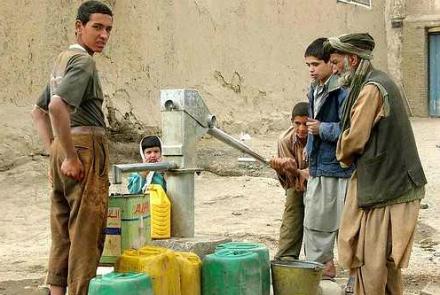The World Food Programme (WFP) on Wednesday welcomed a new contribution of AUD 5 million ($3.6 million) from the Australian government to provide food assistance for people affected by the drought in Afghanistan.
This brings Australia’s total contribution to WFP’s operations in Afghanistan to AUD15 million in 2018.
In a statement issued by the WFP, the organization will use the contribution for a joint response to the drought-affected population in Afghanistan’s 20 provinces.
This includes sourcing wheat grain from the Government of Afghanistan Strategic Grain Reserve (SGR). WFP will distribute the wheat flour to affected families, complementing a food basket with food like fortified vegetable oil, pulses and iodized salt.
“Australia’s humanitarian assistance focuses on supporting the most vulnerable, with a particular focus on women, children and people with a disability,” said Australia’s Ambassador to Afghanistan, Nicola Gordon-Smith.
“Australia is pleased to support this joint response by WFP and the Government of Afghanistan to help provide vital food assistance to affected families,” the ambassador said.
Afghanistan is currently dealing with a severe drought that has affected 20 out of the country’s 34 provinces.
WFP is working with the Afghan government, mainly Ministry of Agriculture, Irrigation and Livestock to release wheat from its reserves. The wheat will be milled, fortified and distributed among families affected by the drought.
“This contribution will enable WFP and partners, including the Government of Afghanistan, to help drought affected women, men and children make it through and build their resilience in this critical period by improving their food security and nutritional needs,” said Naoko Fukunaga, Deputy Country Director for WFP in Afghanistan.
“The Government-owned SGR will play a key role in providing wheat grain for this response,” Fukunaga added.
In 2013, WFP built the SGR main storage facility in Kabul with funds provided by Australia, and in close collaboration with the Afghanistan Ministry of Agriculture, Irrigation and Livestock.
The evolving drought situation exacerbates underlying challenges to food security from conflict and weak labor markets and WFP is preparing for a possible drought response to up to 1 million people.
Aid already needed in numerous provinces
The La Niña weather pattern has had a devastating effect on this year’s planting season, with a rain, snow and sleet deficit of 70 percent prevailing across most of the country.
With last year’s wheat production already reported to be 57 percent below the five-year average, the 2018 harvest is forecast to be even lower: down from 4.2 million metric tons to 3.5 million metric tons, the UN Office for the Coordination of Humanitarian Affairs (OCHA) reported in April.
In May, the International Federation of Red Cross and Red Crescent Societies (IFRC) reported that Badghis, Balkh, Faryab, Jawzjan, Helmand, Nimroz, Uruzgan, Kunduz, Takhar, Herat, Ghor and Farah were among the worst affected provinces.
They said the population in these affected provinces are most likely going to need support in the areas of nutrition and food security, water and sanitation, emergency shelter and non-food items.
In mid-April, the Afghan government launched an appeal for $100 million for immediate livestock protection for an initial two months of assistance for fodder/feed support and an overall demand of $550 million for a 10 months fodder/feed support throughout the 34 provinces of Afghanistan.
According to OCHA, in the 20 provinces most affected by the drought, nearly 15 million people rely on farming, livestock or labor opportunities in agriculture. Of these, an estimated two million people will become severely food insecure due to the drought.
Last month OCHA reported however that 150,000 heads of livestock had died in Helmand due to the drought, and that the water table had significantly dropped in nine districts.
WHO also warned late last month that the lives of one million people are critically affected by drought in Afghanistan and another two million people could be affected in the coming months.
Reuters meanwhile reported this week that the drought across much of Afghanistan is spurring plans to build new dams to help farmers however it is also aggravating tensions with Iran over supplies from the Helmand River - a decades-old dispute that has fed accusations that Tehran is helping the Taliban insurgency.
“We can see the Helmand River water, we can even go touch it, but we can’t bring its water to our farmlands,” said Dawoodzai, who grows wheat and lentils in the southern province of Helmand.
“It is frustrating for every farmer to see large amounts of Helmand River water flowing into Iran.”
Earlier this year, the Taliban threatened to overrun Afghanistan’s western province of Farah, on the border with Iran, drawing angry warnings from local politicians that Tehran was using the insurgents to fight a proxy war over water.
“Iran is supporting the Taliban to disrupt developmental projects in Afghanistan, including water dams,” Gul Nabi Ahmadzai, the former Afghan border police chief told Reuters.
“They benefit from keeping Afghanistan unstable and want to control our resources,” he said.
Iranian diplomats in Kabul declined to comment, Reuters report adding that Tehran has repeatedly denied helping the Taliban.
Officials warn of looming crisis in Kabul
The crisis however is also being felt in Kabul where concerns are rising that the capital’s water supply could dry up within the next few years.
The head of Kabul’s Water Supply Department Sardar Wali Malakzai said on Wednesday that the unregulated practice of homeowners and companies drilling wells for water has resulted in a sharp drop in the underground water levels.
Malakzai said if serious action is not taken to stop this, Kabul will soon face a severe water shortage.
Well-drillers in Kabul meanwhile confirmed the drop in the water table and said they had seen a big difference in water levels this year.
“In Kar-e-Naw hill we dig for 120 up to 130 meters to reach water,” said one well-driller Kheyal Mohammad.
The Ministry of Energy and Water said this week that many homeowners and factories drill illegally. The said the Kabul municipality does not have any mechanisms in place to monitor the situation.
“A number of factories, companies and organizations extract Afghanistan water illegally. From the ministry of energy and water’s point of view, underground water is a strategic resource belonging to the Afghan government,” said Asif Ghafoor, head of office of the ministry.
Earlier this month, the National Disaster Management Authority (ANDMA) also warned that underground water reserves in Kabul will dry up within the next 10 years due to an increasing demand and overuse of water in the capital.
“Kabul’s underground water reserves will dry up within the next 10 years if the situation continues as it is,” Fahim said.
More dams to be built
This week, the Afghan Ministry of Energy and Water said India, in conjunction with the World Bank, will build a new dam on the Kabul river basin – which will provide over two million Kabul residents with potable water.
The ministry said the World Bank-funded Shahtoot Dam project will start in about a month and that it will be in the Chahar Asiab district of Kabul.
Officials said a feasibility study was finalized in 2012 and now the issue of land acquisition is being worked on.
The Asia Foundation meanwhile said recently that more needs to be done to save water, including policy solutions that promote water use efficiency at a consumer level through recycling, wastewater management, water treatment, the harvesting of surface water, and the monitoring of groundwater extraction methods at the ministry level.
To fight the misuse of water, the government needs to step up efforts to promote public awareness by developing a national campaign not only in Kabul, but also in rural and urban areas throughout the country, the foundation said.


